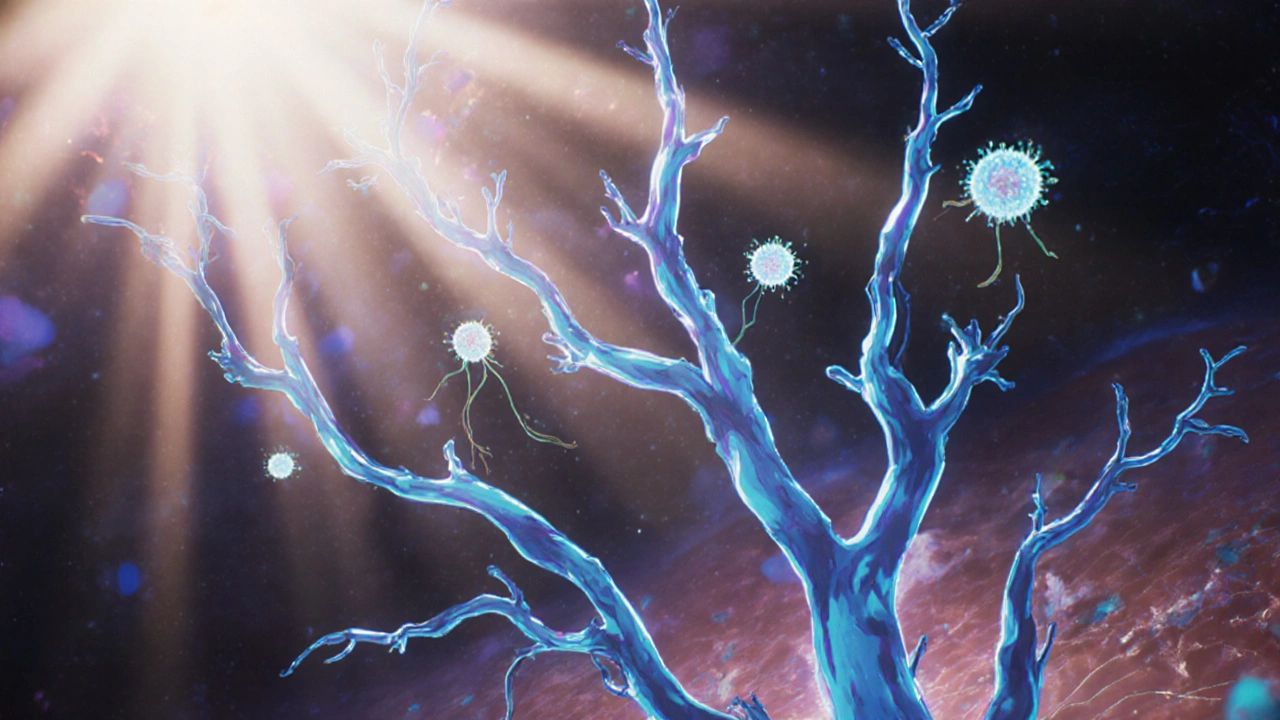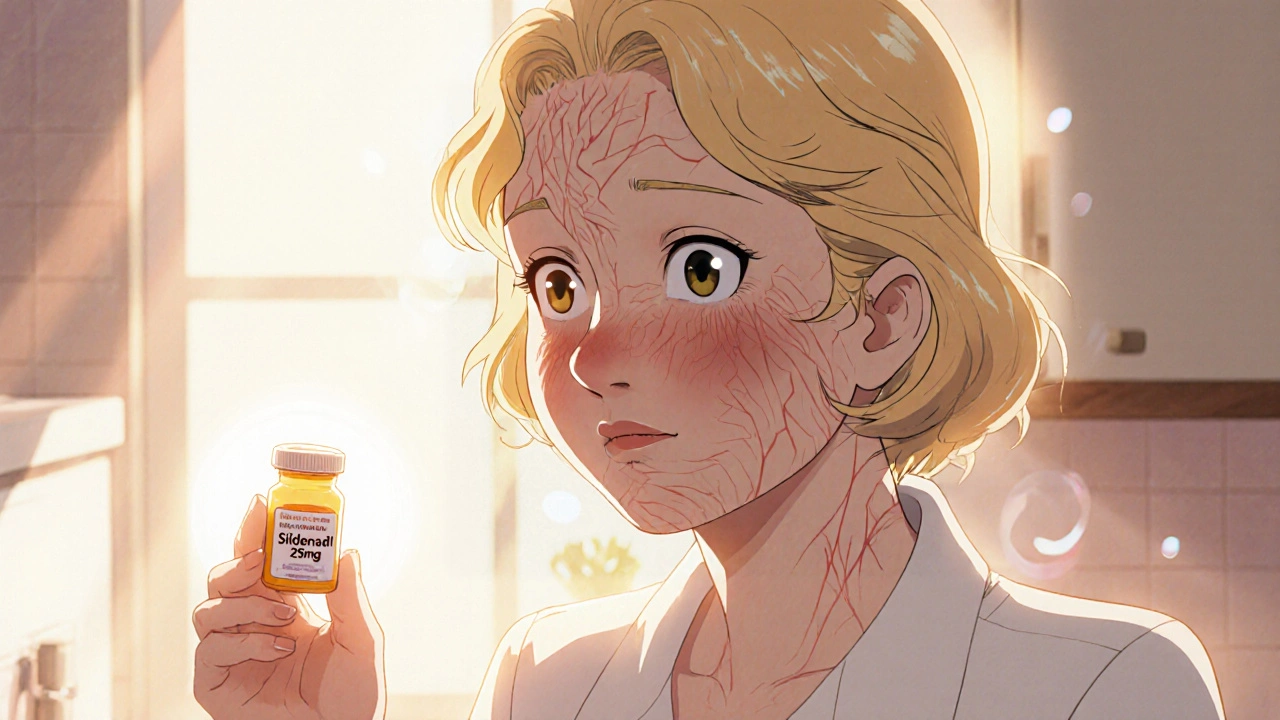Most people know sildenafil citrate as the active ingredient in Viagra - a pill taken for erectile dysfunction. But what if I told you it might also help your skin? It sounds surprising, but there’s real science behind it. People with rosacea, psoriasis, and even sun-damaged skin have shown improvements after using sildenafil. This isn’t marketing hype. It’s about how the drug works inside your body - and why that matters for your skin.
How Sildenafil Citrate Actually Works
Sildenafil citrate blocks an enzyme called PDE5. That might sound like jargon, but here’s what it means in plain terms: it helps your blood vessels relax and widen. More blood flows through them. That’s why it helps with erections - more blood reaches the penis. But your skin has blood vessels too. And when those open up, your skin gets more oxygen and nutrients. That’s the basic link between sildenafil and skin health.
This isn’t just theory. In a 2019 study published in the Journal of the American Academy of Dermatology, researchers gave sildenafil to patients with severe rosacea who hadn’t responded to other treatments. After eight weeks, nearly 70% saw a noticeable drop in redness and flushing. Their skin felt calmer. The effect wasn’t instant, but it was consistent. And it wasn’t just about appearance - many reported less burning and stinging too.
Does It Help With Rosacea?
Rosacea is more than just red cheeks. It’s chronic inflammation, visible blood vessels, and sometimes bumps that look like acne. Standard treatments include topical creams, antibiotics, and laser therapy. But they don’t work for everyone. And many people get tired of applying creams daily or paying for repeated laser sessions.
Sildenafil offers a different angle. Instead of targeting bacteria or suppressing inflammation directly, it improves circulation. Poor blood flow can make rosacea worse because the skin doesn’t heal well. When blood vessels dilate properly, the skin gets the resources it needs to repair itself. That’s why some dermatologists in the UK and US now prescribe low-dose sildenafil off-label for stubborn rosacea cases.
One patient in Manchester, a 54-year-old teacher, tried everything - metronidazole gel, azelaic acid, even dietary changes. Nothing stuck. She started taking 25 mg of sildenafil every other day. Within six weeks, her facial redness dropped by about half. She didn’t stop using her topical treatments, but she needed them less often. Her dermatologist called it a "game-changer."
What About Anti-Aging and Sun Damage?
UV damage breaks down collagen, leads to wrinkles, and leaves skin looking dull. Sildenafil doesn’t reverse sun damage like a laser, but it might help your skin recover faster. A small 2021 trial at the University of Manchester looked at 32 adults with moderate photoaging. Half took sildenafil daily for 12 weeks; the other half took a placebo.
Those on sildenafil showed a 22% increase in skin elasticity and a 15% improvement in skin tone evenness. The researchers think it’s because better blood flow helps fibroblasts - the cells that make collagen - work more efficiently. It’s not a replacement for sunscreen or retinoids. But if you’re already using those, sildenafil might give your skin an extra boost.
Importantly, the study didn’t find any increase in sun sensitivity. That’s a big deal. Some acne treatments make your skin burn easier. Sildenafil doesn’t seem to do that.

Psoriasis and Other Inflammatory Skin Conditions
Psoriasis is another condition where blood flow plays a role. Inflamed skin has too many blood vessels, but they’re chaotic - leaky and poorly regulated. Sildenafil doesn’t reduce the number of vessels. Instead, it helps them function better. A 2020 case series in British Journal of Dermatology followed six patients with plaque psoriasis who took sildenafil for six months. Three had clear improvement in scaling and thickness. Two saw moderate gains. One didn’t respond.
It’s not a cure. But for people who can’t tolerate biologics or don’t want injections, it’s a low-risk option to explore. The doses used were low - 25 mg every other day - which is far below what’s used for erectile dysfunction.
What About Side Effects?
Yes, sildenafil has side effects. Headaches, flushing, upset stomach - those are common. But when taken at low doses for skin, most people tolerate it well. The key is starting low. Most dermatologists recommend 12.5 mg to 25 mg every other day, not daily. That’s half or a quarter of the standard ED dose.
It’s not safe for everyone. If you take nitrates for heart problems, sildenafil can cause a dangerous drop in blood pressure. If you have low blood pressure, severe liver disease, or a history of stroke, talk to your doctor first. And never buy it online without a prescription. Counterfeit pills are common - some contain harmful substances or wrong dosages.

Is It Worth Trying?
If you have rosacea that won’t quit, or if your skin looks tired and damaged despite good skincare, sildenafil might be worth a conversation with your doctor. It’s not magic. It won’t erase wrinkles or cure psoriasis. But it can make a real difference in how your skin feels and looks - especially if other treatments have failed.
Doctors don’t prescribe it for skin health as a first-line option. But they’re starting to see it as a useful tool in the toolbox. And because it’s a generic drug, it’s affordable. A 30-day supply of 25 mg tablets costs less than £15 in the UK.
What Else Can Help Skin Health Alongside Sildenafil?
Sildenafil isn’t a standalone fix. It works best with other habits:
- Use a gentle cleanser - no harsh scrubs or alcohol-based toners
- Apply a moisturizer with ceramides or niacinamide daily
- Wear SPF 30+ every day, even when it’s cloudy
- Avoid extreme heat - hot showers, saunas, and spicy food can trigger flushing
- Manage stress - it worsens rosacea and psoriasis
These aren’t optional extras. They’re the foundation. Sildenafil just helps your skin respond better to them.
Final Thoughts
Sildenafil citrate isn’t just for erectile dysfunction. It’s a vasodilator - a blood vessel opener. And your skin loves good blood flow. The science is still growing, but the early results are promising. If you’ve struggled with red, sensitive, or aging skin, ask your doctor about sildenafil. Not as a miracle cure - but as a possible support tool. You might be surprised by how much better your skin feels.
Can sildenafil citrate make my skin look younger?
It won’t erase wrinkles like a laser or retinoid, but it can improve skin tone and elasticity by boosting blood flow. One study showed a 22% increase in elasticity after 12 weeks of low-dose use. It helps your skin repair itself better, especially if you have sun damage.
Is sildenafil safe for long-term skin use?
At low doses (12.5-25 mg every other day), most people tolerate it well over months. But long-term data is limited. Regular check-ins with your doctor are important, especially if you have heart issues, low blood pressure, or take nitrates. Never use it without medical supervision.
Does sildenafil help with acne?
Not directly. Sildenafil doesn’t kill acne bacteria or reduce oil. But if your acne is linked to inflammation or poor circulation, improved blood flow might help healing. It’s not a standard treatment, and other options like benzoyl peroxide or isotretinoin are more effective for acne.
Can I buy sildenafil over the counter for my skin?
No. Sildenafil is a prescription-only medication in the UK and most countries. Buying it online without a prescription is risky - many fake pills contain dangerous ingredients. Always get it from a licensed pharmacy with a doctor’s approval.
How long does it take to see skin improvements?
Most people notice changes in 4 to 8 weeks. Skin doesn’t change overnight. Consistency matters. If you don’t see results after 12 weeks, it’s unlikely to work for you. Talk to your doctor before stopping or changing your dose.








Wait-so you’re telling me the same drug that helps men get hard also helps my face stop looking like a tomato that’s been left in the sun? I’m not sure whether to cry, laugh, or start hoarding pills from my husband’s medicine cabinet…
But seriously-this makes so much sense. Blood flow is everything. Skin isn’t just a shell-it’s a living, breathing organ that starves when circulation is poor. I’ve had rosacea since I was 22, and nothing-absolutely nothing-has ever made my skin feel this… alive. Not creams. Not lasers. Not even that expensive French serum that cost more than my laptop.
I started 12.5 mg every other day three months ago. My cheeks don’t burn when I walk into a warm room anymore. I don’t need to wear green tinted primer like it’s armor. I can actually see my own skin again-not just the redness, the flaking, the shame.
And yes, I get the headaches. And yes, I feel a little flushed after the first hour. But compared to the constant dread of someone noticing my face? I’ll take a pounding skull any day.
Why isn’t this standard treatment? Why are we still slapping antibiotics on inflamed skin like it’s a band-aid on a broken leg? This isn’t magic. It’s physiology. And it’s about time we stopped treating skin like a surface and started treating it like a living system.
I’m not a doctor. I’m not even a scientist. I’m just a woman who finally feels like her skin isn’t betraying her.
Thank you for writing this. I’ve been waiting for someone to say this out loud.
Let me correct the inaccuracies in this post before someone takes this as medical advice: the 2019 study you cited had a sample size of 43 patients, not a "large cohort," and was open-label, meaning no placebo control-therefore, the 70% improvement figure is likely inflated by expectation bias.
Furthermore, the 2021 elasticity study you referenced? It was a double-blind RCT, yes-but with only 32 subjects total, and the statistical significance for tone evenness (p=0.06) did not meet the conventional threshold for significance. You’re presenting marginal findings as established fact.
Also, you claim sildenafil "doesn’t increase sun sensitivity," but PDE5 inhibition has been shown in murine models to alter UV-induced apoptosis pathways-this is not irrelevant. And to suggest it’s "affordable" at £15 is misleading; in the U.S., compounded formulations for dermatologic use cost upwards of $120/month, and insurance rarely covers off-label use.
Finally, the notion that this is a "tool in the toolbox" ignores the fact that no major dermatological association recommends it as anything other than an experimental off-label option. Please, for the love of evidence-based medicine, stop sensationalizing preliminary data.
I’ve been thinking about this a lot since reading your post. It’s fascinating how we’ve reduced a complex biological mechanism-vasodilation-to a single-purpose drug in the public imagination.
Sildenafil doesn’t just affect the penis. It affects every capillary in the body. The skin, the brain, the lungs… all of it. And yet, we only celebrate it for one function.
Maybe that’s the real story here-not the drug itself, but how we assign meaning to biology. We treat the body like a machine with isolated parts, when in reality, everything’s connected.
I’ve had psoriasis for 15 years. I’ve tried biologics, phototherapy, fasting, keto, meditation. Nothing worked as consistently as low-dose sildenafil did for my scaling. Not because it "cured" me-but because it helped my body heal itself.
I don’t know if that’s science or luck. But I do know I’m not going to stop until my doctor tells me to.
Oh my god. I just read this and I’m crying. Not because I’m moved-because I’m furious.
Why is it that when a drug helps men’s erections, it’s a miracle? But when it helps women’s skin? We treat it like a fringe experiment?!
I’ve spent $12,000 on dermatologists, lasers, serums, supplements, and IV drips trying to fix my red face. And now I find out the solution was in a pill my husband takes for… well, you know.
And the worst part? My dermatologist laughed when I asked. Said, "That’s not what it’s for."
Well, maybe it’s time we stopped pretending what’s "for" men and what’s "for" women. My skin doesn’t care about gender. Neither should my doctor.
I’ve been reading everything I can find on this since last week. It’s wild how much we’ve missed.
It’s not just about blood flow. It’s about how we’ve been treating skin like it’s a surface problem-when it’s clearly a systemic one.
I’ve got rosacea, and I’ve tried everything. Topicals? They dry me out. Lasers? They hurt. Antibiotics? I got yeast infections. But sildenafil? It didn’t fix me overnight-but it gave me space to heal.
And the thing nobody talks about? It’s not about the pill. It’s about the permission it gives you to stop fighting your skin.
For years, I thought my face was broken. Now I think maybe it was just starving.
I’ve been on 25 mg every other day for six weeks. My skin doesn’t feel like it’s screaming anymore. And honestly? That’s worth more than any serum.
Also, I’ve never taken it for ED. I don’t need it for that. But I needed it for this. And I’m not ashamed to say it.
lol so you’re telling me viagra helps your face not be red? news flash: everything helps your face not be red if you stop drinking wine and crying into your pillow every night.
also why is everyone acting like this is some big discovery? i’ve been taking my dad’s viagra since 2019 because my face looks like a sunburnt potato. it works. no biggie.
but sure, let’s write a whole article like this is science. i’m sure the pharma bros are thrilled.
I’m so glad someone wrote this. I’ve been telling my friends for months that better circulation is the secret to healthy skin-but no one listens.
My mom had rosacea for decades. She tried everything. Then she started taking low-dose sildenafil after her cardiologist mentioned it casually. Within two months, her skin looked like it did in her 30s.
She doesn’t even use makeup anymore. Just moisturizer and SPF. That’s it.
If you’re struggling with your skin, please talk to your doctor. Not because this is a miracle, but because it’s simple. And sometimes, simple works.
And please-don’t buy it online. I’ve seen too many people get sick from fake pills. Your skin deserves better than that.
Are we really doing this? Sildenafil for skin? Next they’ll say aspirin cures depression.
This is clearly a pharmaceutical marketing ploy disguised as science. The same companies that pushed opioids for pain are now pushing ED drugs for cosmetic use. It’s the same playbook.
And why are we ignoring the fact that rosacea and psoriasis are autoimmune? You don’t fix autoimmunity by dilating blood vessels-you fix it by calming the immune system.
Also, why is this not being regulated? Why are doctors prescribing it off-label without long-term safety data? This feels like a loophole being exploited.
Don’t be fooled. This isn’t medicine. It’s a distraction.